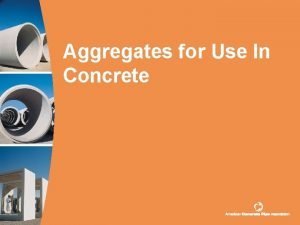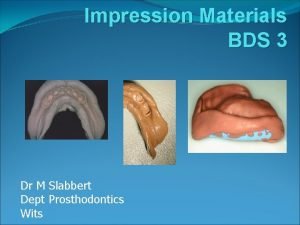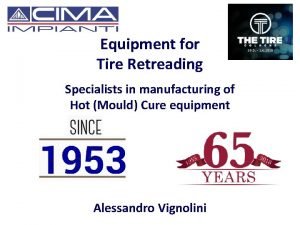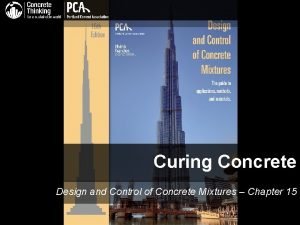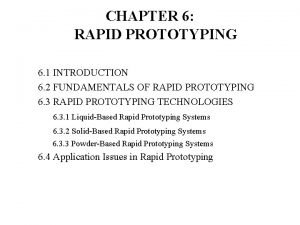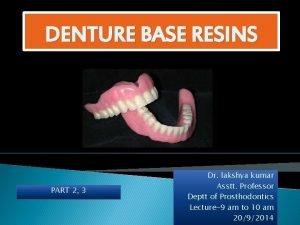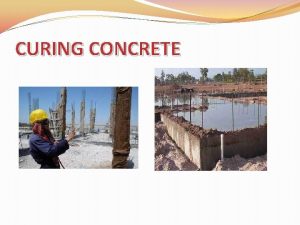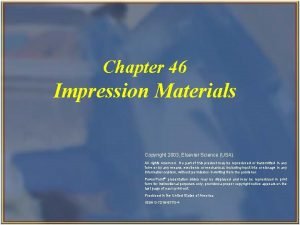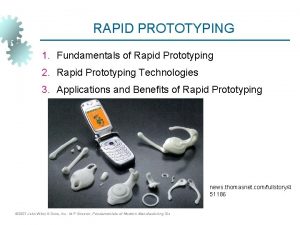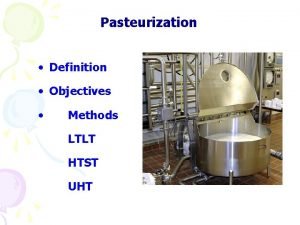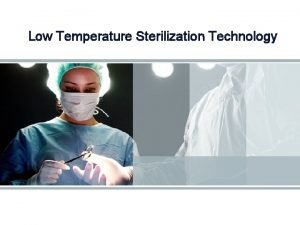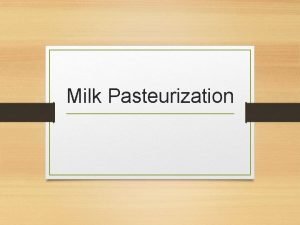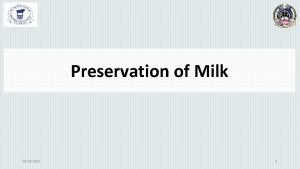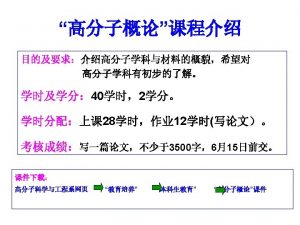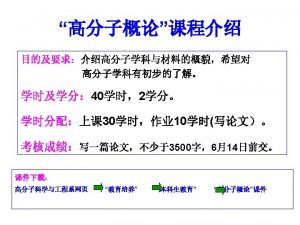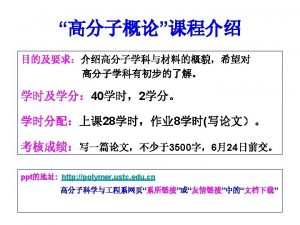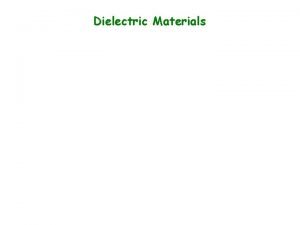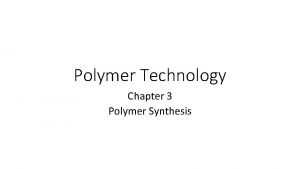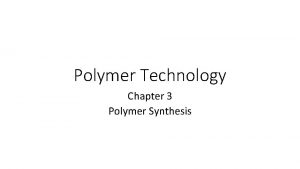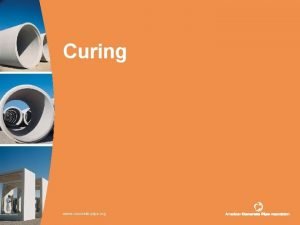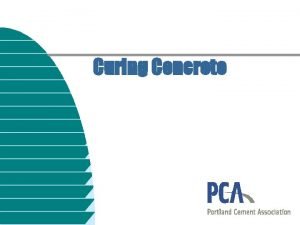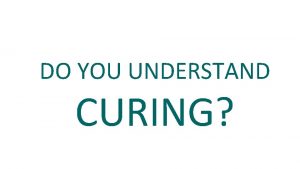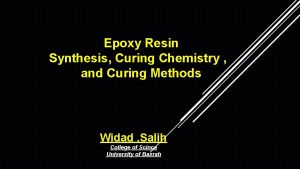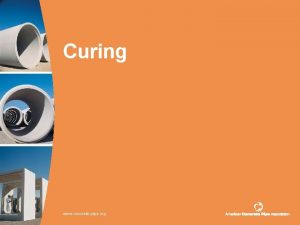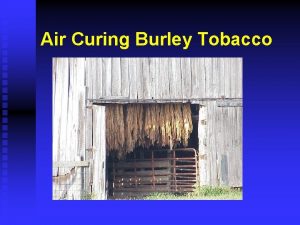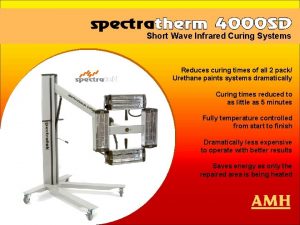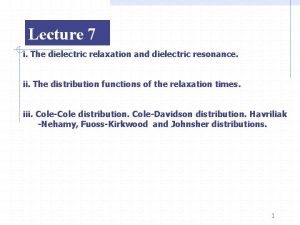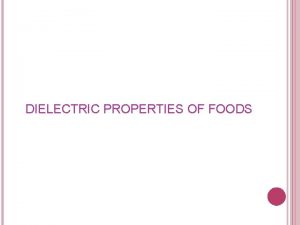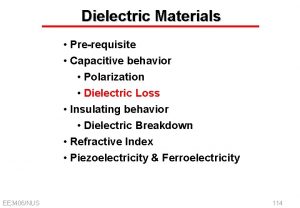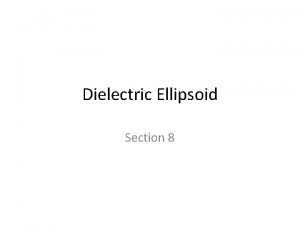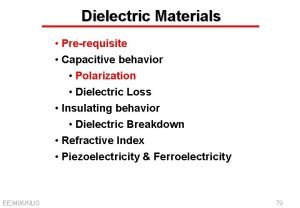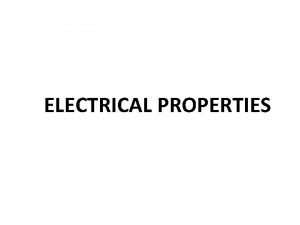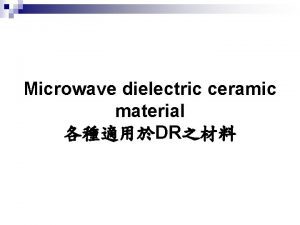Polymer Dielectric Layer Curing Fast Low Temperature Low





























- Slides: 29

Polymer Dielectric Layer Curing Fast, Low Temperature, Low Warpage

Polymer Dielectrics on Wafers q Photosensitive polyimides (PI) § Fast cure at 350°C § Curing below 250°C q Low CTE polyimides § Curing at 200°C § No-warpage processing q Polybenzoxazoles (PBO) § Curing below 200°C § Crosslinking mechanisms q Epoxies and PHS § Curing down to 160°C § Half the warpage at 300 mm

Very Fast VFM Cure of Polyimides q Two polyimides extensively used for stress buffer and RDL § PI-5878 G non-photosensitive polyimide § Coat & soft-bake § HD 4004 photosensitive polyimide § Coat, soft-bake & blanket expose q Oven cure 60 min hold for 5 hr cycle time q VFM Cure at @ 350°C with cycle times less than 30 minutes

PI Cure Properties Meets/Exceeds Oven Cure q Range of results for VFM cure overlaps oven cure for most properties q Differences are consistent with higher cure by VFM Note: “Error” bars for Oven cure results show standard deviation in data. “Error” bars for VFM cure show range of responses from DOE

Fast VFM cure of HD 4110 at 340°C q VFM process capable of same cure as oven with 94% reduction in cycle time q Results averaged for 8 VFM cured films, 9 oven cured films Oven: 60 min@350°C, 5. 0 hr cycle VFM: 8 min@340°C, 0. 3 hr cycle

Chemistry of PSPI Curing q Photosensitive precursor releases residue with ring closure § Acrylate residue is thermally decomposed to CO 2 and other gasses CO 2, other gasses § Removal of residue increases Tg and film shrinkage in out-of-plane axis q TWO parts of “cure”: § imidization : necessary for chemical stability § acrylate removal : necessary for high Tg and thermal stability

Fast VFM cure does not leave residuals q Residual polyacrylates in oven cure (by DMA, TGA, and DSC) TGA DMA shows Tg from polyacrylate and polyimide Weight loss from polyacrylate burn-out Tg of polyacrylate Polyimide Tg is not seen in DSC

Low Temperature Polyimide Curing

Previous Polyimide Results A measure of microwave cure efficiency is the comparison of the final film Tg as cured conventionally and by VFM. q Example: convection cure at 4 hrs at 350ºC for Tg = 310ºC Tg Ratio = 1. 0 VFM cure at 1. 5 hrs at 150ºC for Tg = 310ºC q

VFM Cure of Polyimide at Low Temperatures q Low temperature cure AND faster total cycle times possible? q Compare film properties of oven and VFM cure profiles soak Oven 375 C VFM 270 C VFM 250 C VFM 230 C Standard oven cycle vs. example VFM cycles for HD 4100 q “Cure time” is often given as soak time, not cycle time q Slow oven ramp to soak is used to reduce film stress and warpage

Properties: 375°C oven vs. 230 -270°C VFM q DOE results: These are NOT error bars. They represent the range of real results from changes of variables.

Property Trade-offs q Examples of actual data (equivalent cure by IR): Temp C Time Hrs Oxygen ppm Tg C Td 1% C Td 5% C Stress MPa Bow mm Standard 375 C 5 <100 310 487 37. 3 63 Standard * 350 C 5 <100 256 382 432 28. 3 VFM * 350 C 0. 2 <20 330 463 497 31. 6 VFM 230 3 air 282 336 394 31. 8 67 VFM 250 2 air 306 365 429 VFM 270 1 air 337 374 454 44. 5 77 VFM 270 1 <20 236 392 30. 6 62 q Lowest cure (230°C) has similar bow; lower Tg q Medium cure (270°C) has similar Tg; higher bow q Long ramp to soak not necessary with VFM * Zussman et. al. , Symposium on Polymers, 2008

CTE-Matched Polymer Dielectric q Needs for a dielectric layer for 2. 5 D § § § CTE = 3 -4 ppm/°C Good dielectric properties and stability Low stress and warpage Compatibility with under 250°C processing High Volume Manufacturing Solution Dielectric Material Si. O 2 Silicon Glass BT, FR 4 Polyimide BCB Epoxy PBO CTE (ppm/°C) 0. 5 3 4 18 35 42 60 60 Standard oven cure 250 -375 C

Extent of PI-2611 Cure with VFM at 200°C q 98 -100% imidization after 30 minutes q Ramp rates are fast (> 30°C/min) but don’t affect cure/stress/warpage

Same Semi-crystalline Thermoplastic? Oven cure ≥ 350°C begins densification/crystallization § VFM cure at 200°C (well below Tg∞ and Tg) § CTE of 3 ppm/°C and modulus of 7 GPa § highly anisotropic, layered, linear structure remains § § § No indication of crystallization and 5 X increased stress CTE-matched cured film to silicon and glass

Warpage of Cured Films on Thinned Silicon q Warpage vs. temperature (Projection Moiré Interferometry ) Silicon dice 27 mm x 19 mm x 100 mm 5 mm thick PI less than 15 mm warpage q Bow of 200 mm diameter wafers ground to 100 um thickness: After grinding After 350°C oven After 200°C VFM -100 um -86 um -95 um

Temporary Bonding Remains q 200 mm wafers temporarily bonded to glass carriers q VFM cured films on backside 250°C cure unwanted adhesion 200°C cure temporary adhesion

Low Temperature Curing of PBOs with VFM

PBO Curing is More Complex q Advantages of polybenzoxazole (PBO) dielectric films § § Similar thermal and chemical stability to polyimides (PI) Aqueous development rather than solvent-based Higher elongation to break than polyimides Lower temperature cure potential ( less than 300°) q Cyclization and crosslinking reactions

First Set Chain-extension Data q Twice the extent of chain-extension by 200°C with VFM. q Chain-extension slowing by 250°C with oven.

Molecular Design q If the primary goals are highest cyclization and highest Tg: § Use an alicyclic backbone and a crosslinking agent with a low dipole moment § If an aromatic backbone is preferred, then use a high dipole agent § Use a cyclization promoter and a low dipole endcap § If a high dipole encap is used, the promoter doesn’t matter § Use NMP solvent rather than GBL q To decrease the residual solvents and water in the film § For an alicyclic backbone use low amount crosslinking agent § For an aromatic backbone use high amount crosslinking agent § Use a high dipole endcap with promoter § OR a low dipole endcap with/without promoter q Note that Time and Temperature are relatively unimportant!

Confirmation Runs q q q Results suggest confirmation runs: Backbone Crosslink dipole Crosslink amt. Endcap dipole Promoter 1 Alicyclic 6. 53 low 2. 66 addn 2 Aromatic 7. 56 low 2. 66 addn 3 Aromatic 7. 56 high 2. 66 addn Predicted results from the models: Mtl-Temp Cycl. % Tg Td 5% 1 -170 C 101. 4 286. 3 312. 0 1 -185 C 108. 9 248. 6 353. 6 1 -200 C 116. 3 210. 8 395. 2 2 -170 C 93. 7 264. 1 380. 9 2 -185 C 101. 2 226. 3 422. 5 2 -200 C 108. 7 188. 6 464. 0 3 -170 C 93. 4 255. 5 334. 7 3 -185 C 100. 9 248. 1 376. 3 3 -200 C 108. 3 240. 7 417. 9 Eighteen patterned wafers to determine effect on via slope (5 & 7 mm)

Summary q PBO polymers can be custom synthesized for: § Low temperature curing with VFM § Unique mechanical properties § As a result of the low temperature – fast cure § As a result of the uniform bulk cure of VFM q Next steps § § Analysis of confirmation/photolithography runs Further refinement and selection of structures Feedback from users of PBO films for passivation and WLP Investigation of epoxy materials in progress

2007 Update on Patterned Wafers q Custom designed HD 892 X for VFM § § § Confirmation runs led to more optimized formulation 185°C full cure (Tg = 270°C) Elongation 70 -80%, full adhesion, chemically resistant Smooth via profile from VFM processing Released for sampling to industry oven cured VFM cured 24

Low Warpage Epoxy Wafer Cure

Completeness of Cure q Measurement of Tg of conventional and VFM cure samples WPR-1201 (not including ramp times) q Ramp conditions: convection - 30 min up, 30 min down VFM - 3 min up, 3 min down 26

Wafer Size and Warpage q Significant reduction with 300 mm wafers even at less than 15 min q At higher temperatures (250°C) warpage remains low 27

Low Temperature Cure with VFM (neg) n n Extent of cure measured by solvent (NMP) resistance No cracking found after solvent exposure and drying Temp(°C) / time(min) Before (mm) 200 / 10 185 / 25 160 / 60 250 / 60 C n n n After (mm) % change 20. 71 0. 05 20. 35 0 20. 23 20. 22 -0. 05 20. 53 20. 51 -0. 1 20. 88 20. 87 -0. 05 20. 48 0 20. 17 0 200°C complete cure of WPR-1201 (10 min) 185°C complete cure of WPR-1201 (25 min) 160°C complete cure of WPR-1201 (60 min) 28

Low Temperature Cure with VFM (pos) n n Extent of cure measured by solvent (NMP) resistance No cracking found after solvent exposure and drying Temp (°C) / time (min) Before (mm) 200 / 25 180 / 45 160 / 90 200 / 120 C n n n After (mm) % change 20. 51 20. 5 -0. 05 20. 52 20. 53 0. 05 20. 09 20. 1 0. 05 20. 24 20. 26 0. 1 20. 54 20. 72 0. 88 20. 62 20. 76 0. 68 20. 55 20. 56 0. 05 200°C complete cure of WPR-5200 (25 minutes) 185°C complete cure of WPR-5200 (45 minutes) 160°C complete cure of WPR-5200 (90 minutes) 29
 Example of acid-fast bacteria
Example of acid-fast bacteria Acid fast and non acid fast bacteria
Acid fast and non acid fast bacteria Chapman flask moisture chart
Chapman flask moisture chart Mucostatic impression material
Mucostatic impression material Tire retreading automatic buffing machine
Tire retreading automatic buffing machine Impervious paper curing
Impervious paper curing Solid ground curing
Solid ground curing Denture base parts
Denture base parts Define curing of concrete
Define curing of concrete Solid ground curing
Solid ground curing Concrete constructing forms and curing vocabulary
Concrete constructing forms and curing vocabulary Ch 46 impression materials
Ch 46 impression materials Powder based rapid prototyping
Powder based rapid prototyping Difference between curie temperature and neel temperature
Difference between curie temperature and neel temperature Ferromagneti
Ferromagneti Difference between curie temperature and neel temperature
Difference between curie temperature and neel temperature Layer-by-layer assembly
Layer-by-layer assembly Chemical digestion
Chemical digestion Secure socket layer and transport layer security
Secure socket layer and transport layer security Layer 2 vs layer 3 bitstream
Layer 2 vs layer 3 bitstream Secure socket layer and transport layer security
Secure socket layer and transport layer security Secure socket layer and transport layer security
Secure socket layer and transport layer security Layer 6 presentation layer
Layer 6 presentation layer Layer 2 e layer 3
Layer 2 e layer 3 Pigmented layer and neural layer
Pigmented layer and neural layer Secure socket layer and transport layer security
Secure socket layer and transport layer security Low temperature long time pasteurization
Low temperature long time pasteurization Low temperature sterilization
Low temperature sterilization Methods of pasteurization
Methods of pasteurization Lacroferrin
Lacroferrin


